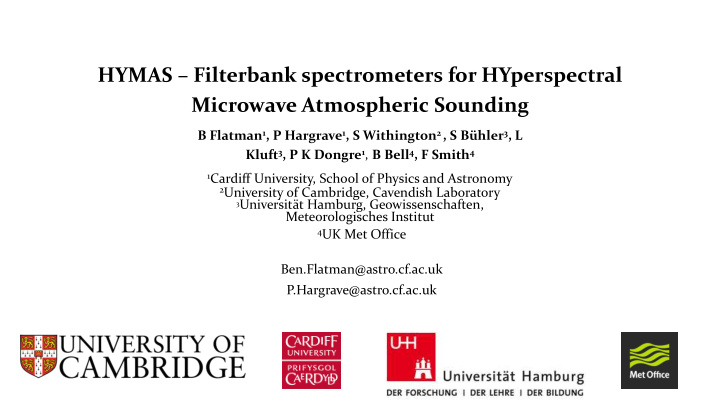



HYMAS – Filterbank spectrometers for HYperspectral Microwave Atmospheric Sounding B Flatman 1 , P Hargrave 1 , S Withington 2 , S Bühler 3 , L Kluft 3 , P K Dongre 1 , B Bell 4 , F Smith 4 1 Cardiff University, School of Physics and Astronomy 2 University of Cambridge, Cavendish Laboratory 3 Universität Hamburg, Geowissenschaften, Meteorologisches Institut 4 UK Met Office Ben.Flatman@astro.cf.ac.uk P.Hargrave@astro.cf.ac.uk
Question: Can we achieve the same performance with a microwave instrument under cloudy sky conditions as infrared instruments under clear sky?
What is the current state of atmospheric sounders? IR sounders MW sounders Hyperspectral MW • IASI, AIRS • AMSU-A/B, MWS, MWI • HYMAS • 2378-8534 channels • 5 – 26 channels • 100 – 1000 channels • 19-83 THz • 18.7 - 229 GHz • 50 - 850 GHz • NEDT 0.14 - 2.0 K • NEDT 0.15 – 1.2 K • NEDT 0.007 – 0.024K • Good performance • Poor vertical resolution • Same as MW but: • Limited to clear sky • Can see down into • Increased channels conditions only cloud • Higher Sensitivity
Why do we need a Hyperspectral solution? Improvement in Temperature and Water vapour retrievals Increased data synergy by combining a hyperspectral MW & IR data Impact to future Numerical Weather Prediction
Why do we need a Hyperspectral solution? Increase in channels provide an increase in information content Improved retrieval of hydrometeor variables such as ice particle size Ability to help constrain Global Circulation Models (GCMs) by improving the understanding of radiative effects Figure: Birman, Camille, et al. "Information content on hydrometeors from millimeter and sub-millimeter wavelengths." Tellus A: Dynamic Meteorology and Oceanography 69.1 (2017): 1271562.
How will we achieve this?… HYMAS! Possesses key benefits over optical gratings or Fourier Transform Spectrometers (FTS) HYMAS is an on-chip Integrated Filterbank Spectrometer (IFBS) Based on current state of the art spectrometers such as DESHIMA, SuperSpec and CAMELS in development for astronomy applications
Transition Edge Sensors (TES) Absorber TES TESs can reach the important 50-60GHz O 2 lines, SQUID Kinetic Inductance Detectors (KIDs) cannot. Can be read out with Superconducting Quantum Interference Devices (SQUIDs) Traditionally require long Silicon Nitride legs to Weak thermal link improve sensitivity Bath
Few-Mode Ballistic TESs Few-Mode Ballistic Transition Edge Sensors • Ultra-Compact • High Sensitivity • High Dynamic Range • Highly Robust Improved physical understanding due to Few- Mode Ballistics Figure:Osman, Djelal, et al. "Transition edge sensors with few-mode ballistic thermal isolation." Journal of Applied Physics 116.6 (2014): 064506. APA
In conclusion • Ultra compact, microwave spectrometer using novel Few-Mode TES technology • High future potential impact to Numerical Weather Prediction and Global Circulation Models • Temperature and humidity retrievals to equal or exceed current or future planned hyperspectral IR instruments
Thank you for your time Ben.Flatman@astro.cf.ac.uk P.Hargrave@astro.cf.ac.uk
Recommend
More recommend